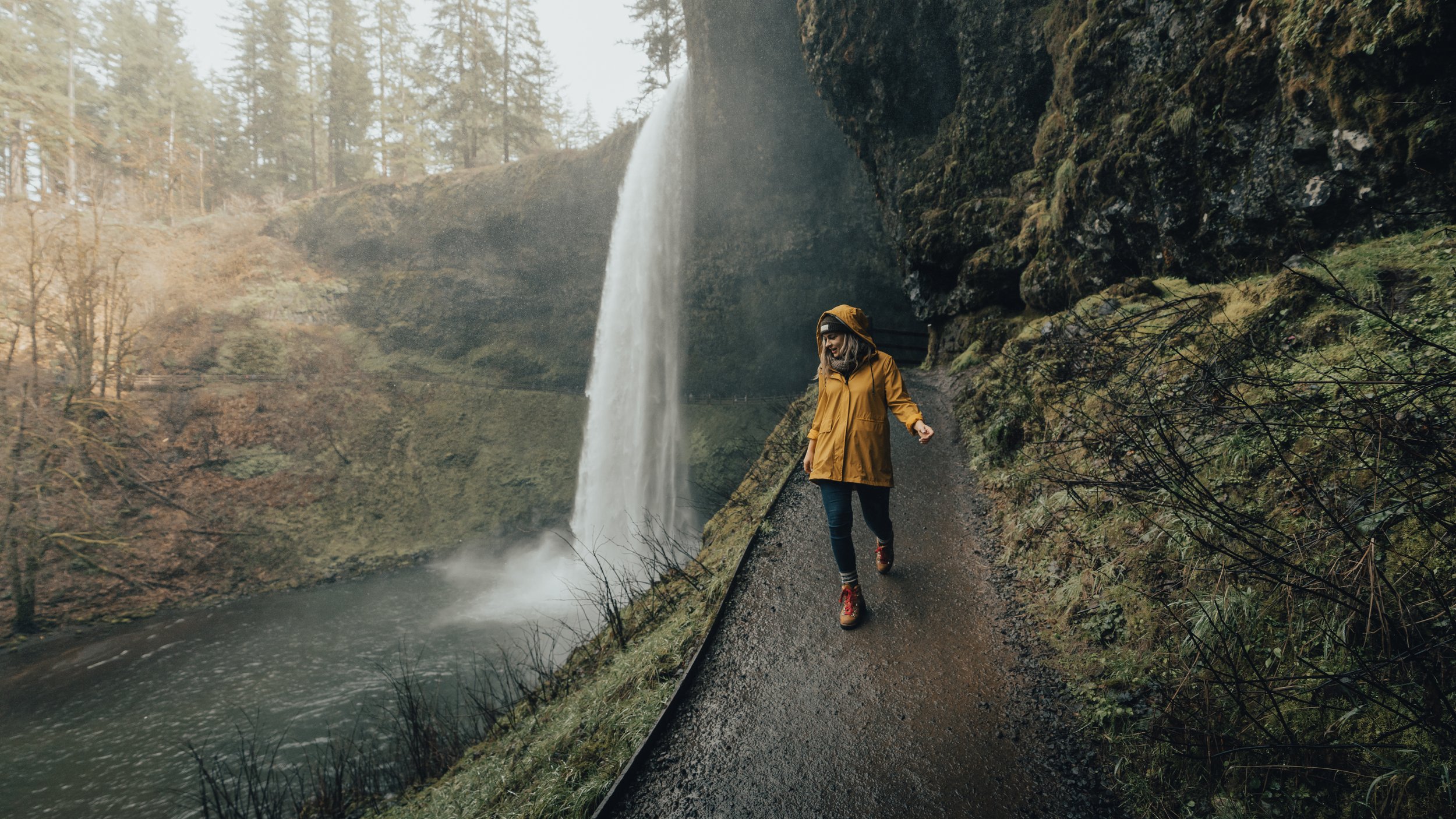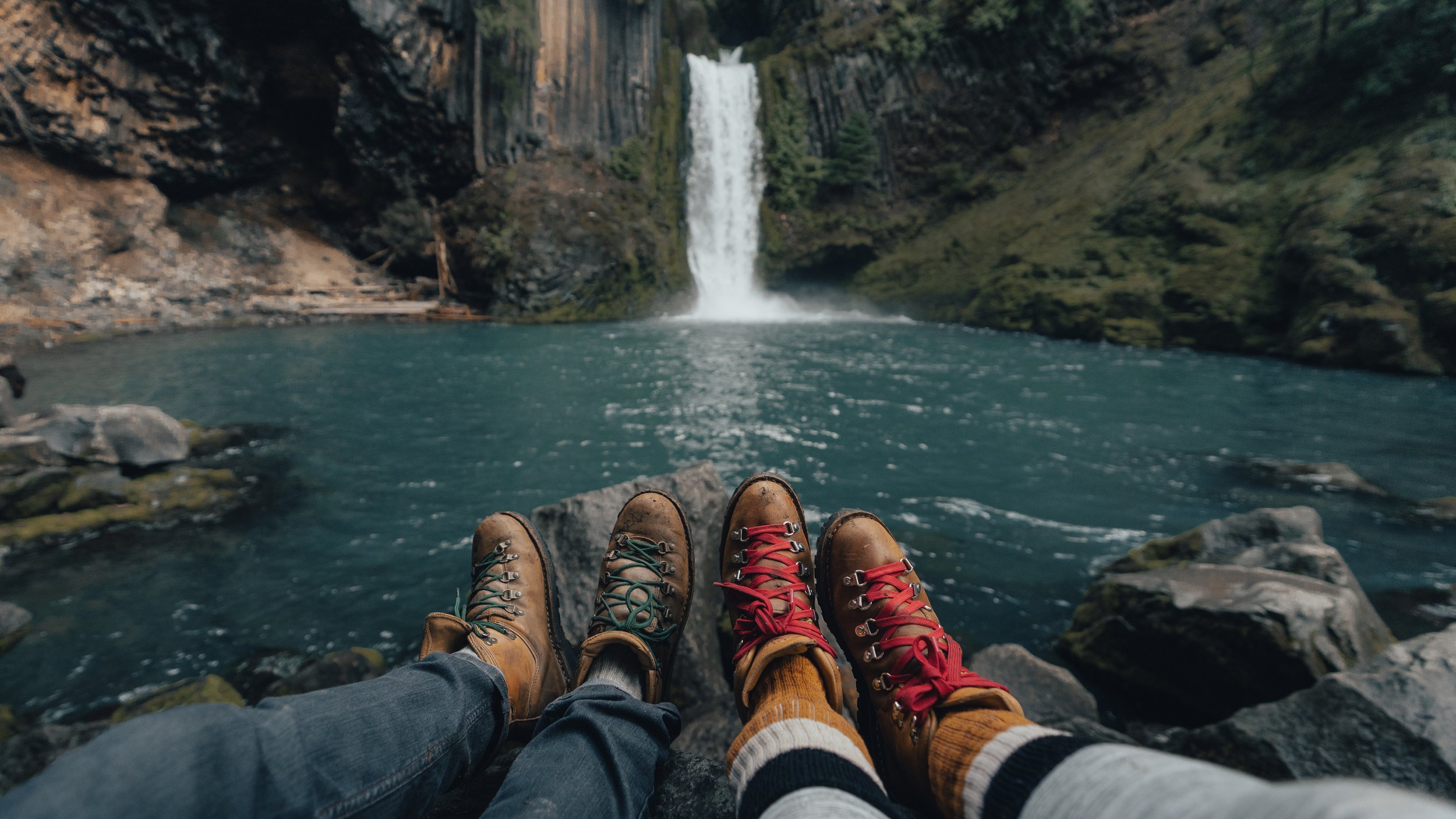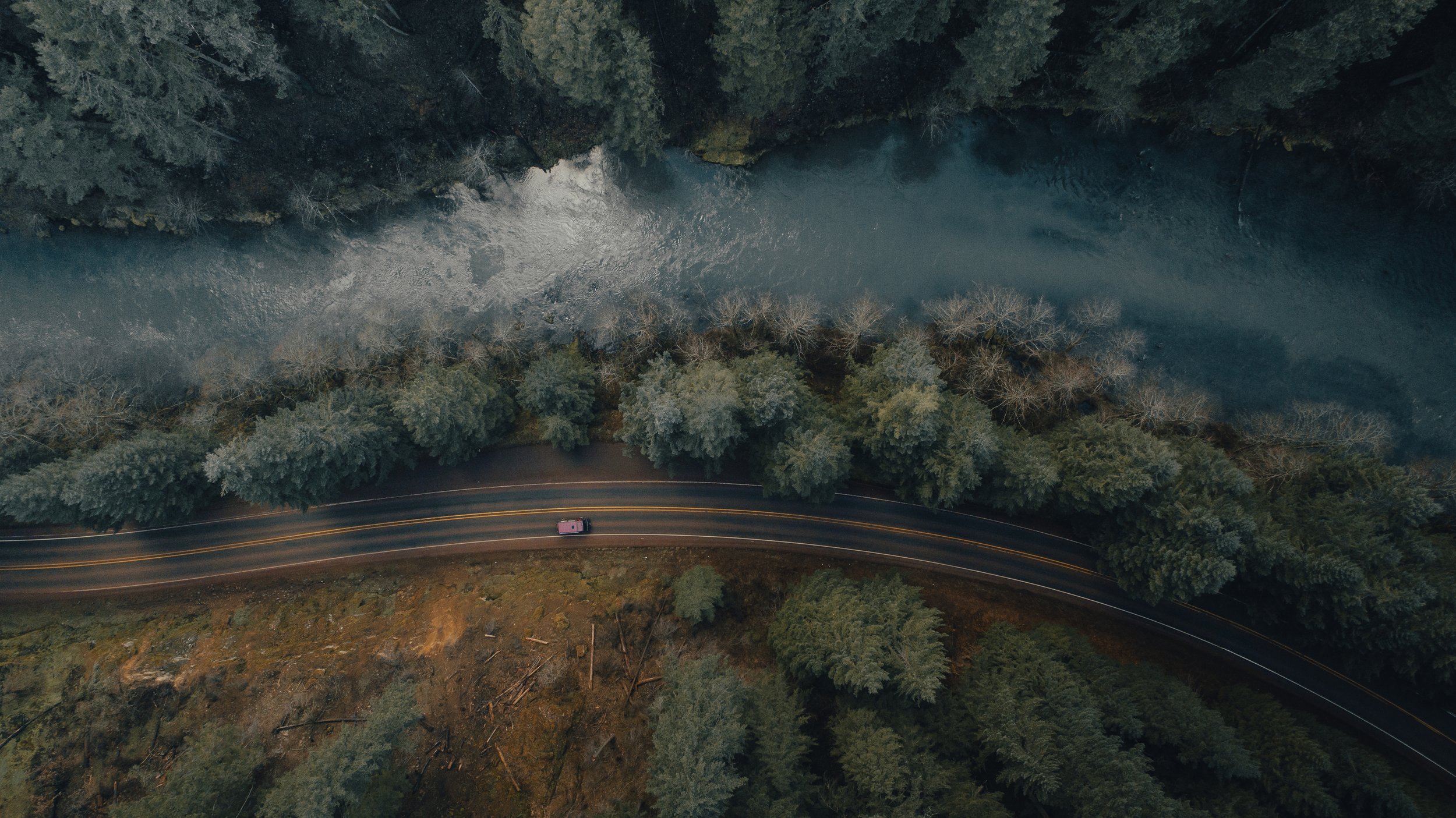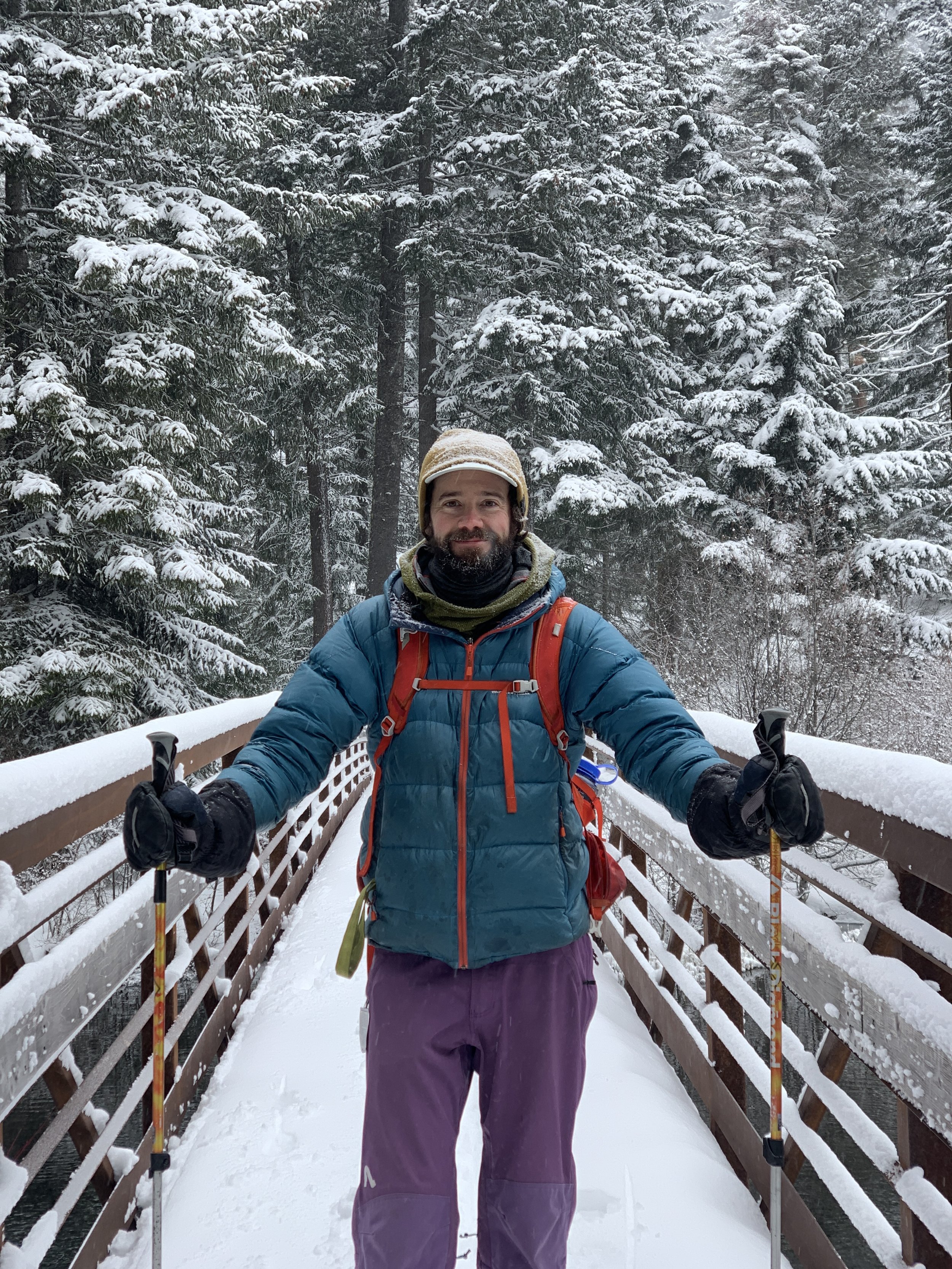BEGINNER’S GUIDE TO WINTER HIKING
Winter Hiking Tips from the Experts at American Hiking Society
Just because the temperature has fallen like the doesn’t mean you can’t have an enjoyable hike outside. With a little extra preparation, hiking in the winter can be every bit as enjoyable as hiking during the warmer months. We’ve teamed up with our friends at American Hiking Society to bring you the best tips on winter hiking in the Pacific Northwest.
American Hiking Society works to provide equitable access to our public lands and trails, and to steward and care for these special places. The nonprofit empowers all communities to enjoy, share, and preserve the hiking experience—advocating for the protection and expansion of hiking spaces, fostering trail stewardship, and collaborating with partners whose strengths are complementary.
Winter can be one of the most peaceful seasons to enjoy some solitude on the trail, but it also comes with some extra preparations and precautions. Before you venture out, follow these 13 winter hiking tips from American Hiking Society to stay safe, warm, and happy.
#1 Check the conditions
Trail and road crews aren’t as active in the winter, so it’s always a good idea to check trip reports to get a sense of conditions on the trail and access to the trailhead before you hit the road.
#2 Dress in layers
While it’s nice to have a huge, fluffy parka on the ski slopes, it isn’t really practical for the trail. Instead, take several layers you can peel off or put on. Your base layer should be a wicking fabric that will pull sweat away from the skin. Pack layers for every part of your body, not just your torso. Overheating is a dangerous threat since excessive moisture that isn’t allowed to escape can freeze and cause hypothermia. If you ever wondered why some of your jackets have zippers under the armpits, they help vent sweat vapor and prevent your clothes from getting wet. Pack extra layers for when you take breaks or in case you are delayed due to an injury or unforeseen situation. Always check the forecasted low temperatures so you’re prepared for the unexpected. Carrying all of the 10 Essentials of Hiking is especially important in the winter.
#3 Wear a hat
Our heads are filled with oxygen-carrying capillaries which fuel our brains and consume a third of the body’s energy. WHOA! During the colder months, it’s important to keep your head covered to maintain function and not lose precious body heat. You may want to bring a warmer/heavier hat for rest periods.
#4 Keep the breeze out
An often overlooked jacket feature—a hooded jacket—helps seal out frigid air from around the neck and shoulders. Hoods also help with layering the head. Throwing on a hood can help regulate your temperature during breaks.
#5 Keep your water bottle warm
Staying hydrated in cooler temps is just as important as it is in the summer. Take extra precautions to keep your water from freezing.
A foam sleeve like a koozie will increase the time it takes water to freeze in a bottle. In very frigid temps, some hikers will even add an active hand warmer inside the insulative sleeve.
Water tends to freeze at the top of a water bottle, so carry the bottle cap down to prevent the opening from freezing first. Ensure the bottle properly seals to prevent leaks.
Start your hike with warm water instead of cold tap water to slow down the freezing process.
Nothing warms your body or your spirits like a warm beverage on the trail or by a campfire. Vacuum-sealed water bottles and thermoses can help keep warm drinks steamy for hours, and they can also be used as standard water bottles.
Sip water often to stay hydrated and also to check the state of your water. Is it starting to freeze?
Do you hike with a hydration reservoir? Manufacturers make special hose, bite valve, and reservoir sleeves to slow down the water from freezing, but in many cases, reservoirs will freeze faster than traditional water bottles.
Store soft-sided flasks or slim water bottles on the inside of your jacket—properly sealed, of course.
#6 Watch your step
Snow and ice are often synonymous with cold-weather hiking. Adequate footwear and traction are part of the 10 Essentials of Hiking, and snow and ice present various hazards in the winter. The conditions should influence what traction devices are used. In deep snow, snowshoes reduce how much a hiker sinks into the powder. On packed snow and ice, micro-spikes and other traction devices provide additional traction for better footing. Many brands design traction that can slip over shoes and boots, and different designs are suitable for different conditions, terrain, and activities. Trekking poles are also highly recommended, especially in snowy and icy conditions. Poles provide more points of contact with the ground, which increases balance and traction.
#7 Keep batteries warm
Batteries in most electronics lose their effectiveness in cooler temperatures. Pack batteries and electronics in interior pockets so body heat can keep them warm. This is especially important if you use any electronic devices as a primary form of navigation. We recommend hikers carry paper maps and a compass (and know how to use them) in the event a navigation device malfunctions.
#8 Don’t toss the sunscreen
While this is most important if you are hiking in a snowy region, winter hikers often forget about the sun’s glare reflecting off of white snow.
#9 Protect your eyes
UV-rated snow goggles or sunglasses that provide adequate protection from bitter wind and the sun's harsh rays should be used even when it's cloudy and not super bright at the beginning of a hike.
#10 Pack freeze-resistant snacks
It can be discouraging to take a snack break only to find your favorite snack hard as a rock and uneatable in cold temps. Chewy and gooey snacks often become hard to eat in winter conditions. Either keep these snacks in an interior pocket or pack snacks that are less affected by cold temps. You can test which snacks work best by putting various snacks in your freezer to see what gets too hard to enjoy out on the trail. Crackers, nuts, and solid chocolate typically work well. Warm snacks are oven more appetizing when it's cold outside so consider stashing your next snack in an interior pocket to warm it up a little before your snack break.
#11 Be prepared for shorter days
As early as October, dusk settles earlier and more quickly than in the summer. Have a good idea of the usable daylight hours before going hiking. Always carry a headlamp or flashlight with extra batteries.
#12 Avalanches
Traveling in avalanche terrain requires additional training and gear to manage safely. Popular hiking trails may cross hazardous slopes, so hikers must be aware of their surroundings. Evaluate the slopes above and below you, and when in doubt, play it safe and avoid the area. If you hike in areas known for avalanches, consider taking an avalanche awareness class at the very least.
#13 Sleep nice and toasty
If you plan to camp in cold temps, you might not have to bulk up with a heavier sleeping bag for winter camping. Putting a liner inside a 20-degree bag is an inexpensive way to boost your bag’s rating by another 10 or so degrees. Some brands even make sleeping bag covers that can increase the temperature rating of your sleep system.
In addition to these tips, remember to follow normal safety practices when hiking in the winter. Be sure you know how to properly use the gear you take with you, and if you have any specific questions, ask a local outdoor expert.
5 Winter Hikes in the Pacific Northwest
The Pacific Northwest is one of the best places for winter hiking. From mild coastal ambles to snow-capped vistas, there are plenty of options to get outside all year round for every type of hiker. Discover some of our favorites below.
Deception Pass State Park
This is one of Washington’s most visited state parks for a reason. The park has miles of rugged coastline, beaches, and groves of dense cedar, pine, and spruce forest to explore. If you’re lucky, you might even see a passing pod of whales, seals, sea lions, or one of the hundreds of shore birds that frequent the area. There are over 38 miles of trails open to hikers, bikers, and equestrians with 1.2 miles of ADA hiking trails. Proximity to Puget Sound regulates the temperatures here, keeping this location mild and snow-free almost year-round, making it a great spot to get outside during the winter. There’s an added bonus of this location being in the rain shadow of the Olympic Mountains, meaning you might even catch a dry day out here in the winter—a rare treat in the Pacific Northwest!
Glacier Vista Snowshoe from Paradise at Mt. Rainier National Park
Pack your snowshoes and head up to Paradise on a clear day for stunning views of Mt. Rainier, the Tatoosh Range, Mt. Adams and Mt. St. Helens in the distance. Be prepared to travel on snow starting from the parking lot, and make sure to check with rangers about snow and avalanche conditions prior to heading out. This hike is a true winter wonderland, with excellent views in every direction on a sunny winter day.
Wallace Falls State Park
Visiting a waterfall is a great option for a rainy day. This trail can be muddy, but there is seldom snow on it making it easily accessible year-round. Stop and enjoy the many viewpoints of Lower, Middle, and Upper Wallace Falls along the way.
Artist Point
If you’re comfortable traveling in avalanche terrain, Artist Point is one of the best places to experience a true winter wonderland. On a clear day, you will be treated to views of Mt. Baker and Mt. Shuksan at one of the snowiest places on earth. In 1999, Mt. Baker set the world record for snowfall in a single season, and its volume of snow and ice is greater than that of all the other Cascade Volcanoes (except Rainer) combined. Be very cautious here, and only travel through this area if you are trained and prepared to navigate avalanche terrain.
Sol Duc Falls in Olympic National Park
This beginner-friendly hike winds through the temperate rainforest in Olympic National Park along the Sol Duc River and ends in a beautiful canyon with three tiered waterfalls. Winter visitors can soak in views of misty trees covered in moss from 170 inches of annual rainfall. Extend your stay and warm up at the Sol Duc Hot Springs just down the road from this great winter hike.
Ready to hit the trail?
Check out our fleet of rental vans or Metris conversions for sale!







